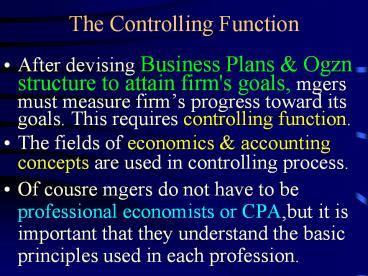The Controlling Function - PowerPoint PPT Presentation
Title:
The Controlling Function
Description:
The Controlling Function – PowerPoint PPT presentation
Number of Views:39
Avg rating:3.0/5.0
Title: The Controlling Function
1
The Controlling Function
- After devising Business Plans Ogzn structure to
attain firm's goals, mgers must measure firms
progress toward its goals. This requires
controlling function. - The fields of economics accounting concepts
are used in controlling process. - Of cousre mgers do not have to be professional
economists or CPA,but it is important that they
understand the basic principles used in each
profession.
2
- Cost Controls Break-Even Analysis
- Objective show how to manage costs
determine most profitable level of pdn sales
that satisfies consumer needs - Cost assists mger to assess how bus. has
performed in past to plan for the future - This requires a good mgmt info system that will
provide - (1) acctg info that allows mgmt to determine cost
in various ways - (2) a means for effectively monitoring
controlling costs of the business.
3
- Mger use costs in decision making, thus need to
know how costs will respond to changes in
business activities. - Mgmt InfoAcctg records are sources of mgmt info
as they summarize transactions like inventory
turnover, eqpt purchases etc - Mgmt Info as Control Function Mgmt info is used
in controlling resources obtained used by firm.
- Defining Costs
- A firm's info system must provide data needed for
cost control to ensure that costs are being
allocated properly that all relevant costs are
being considered.
4
- Implicit and Explicit Costs
- Explicit Cost Costs that are directly traceable
to the end product e.g. cost of input purchased
at open market for which explicit payments are
made. - Implicit Cost Are costs that firms incur that do
not involve explicit payments. They relate to
firm's use of its own assets e.g. cost for
using building, eqpt, labor, dep. interest must
be added to determining final cost of producing
pdts.
5
- Controllable and Non-controllable Costs
- Uncontrollable costs Costs firms cannot easily
influence e.g. implicit costs that mgers have
limited control. - Controllable costThose regulated totally by
mgers e.g. explicit costs - Fixed Variable Costs
- Costs vary according to two concepts
- (1) the passage of time, and
- (2) the level of activity.
- Fixed CostsStay same over time regardless of the
level of output -e.g. rent - Variable Costs change with the level of activity
(materials, labor, shipping).
6
- The figure shows that TC TVC TFC.
- The Contribution Concept
- Price profit are determined on per unit basis
that shld cover FC VC. - SP per unit TC per unit Profit per unit
- SP per unit FC/unit VC/unitProfit/unit
TC
Cost
TVC
Fixed cost
TFC
Output
7
- Fixed costs are usually referred as overhead
cost. - SP/unitOverhead cost/unitVC/unit Profit/unit
- SP/unit - VC/unit Overhead cost/unit
Profit/unit
8
- e.g. if a rice producer has the ff cost
- Materials 55/bag Direct labor 20/bag Then TVC
is 75/bag - If SP/bag is 125, then 50 is left after paying
for TVC to contribute to overhead (TFC) profit - Selling Price 125/bag 100 - TVC
75/bag -60 Contribution 50/bag 40
(profit overhead)
9
- Contribution covers profit overhead
- SP/unit - TVC/unit Contribution Overhead/unit
Profit/unit - If a firm know its contribution margin to be 40,
its SP for any item can easily be computed, once
its VC/unit is known - If a firms contribution is 60, its VC is
200/unit then its - SP 100 VC Con 40 60
- If VC 40 200 then
SP 100
100/40 x 200 500
10
- Break Even Analysis
- Helps to find sales/output level that yields no
profits or losses - i.e. where TR TC - CalculationProfit 0 Revenue TC
- Profit 0 (P x Q) (VC x Q) FC
- 0 Q(P-VC) FC
- Q(P-VC) FC
- Q FC/(P-VC)
11
- If rice SP is 200/bag with 120 VC, 1mil FC
then how many can be sold to break even? - Calculation
- Break-Even
- Q FC/(P-VC)
- Q 100,000/(200-120) 1000000/80
12,500 bags































